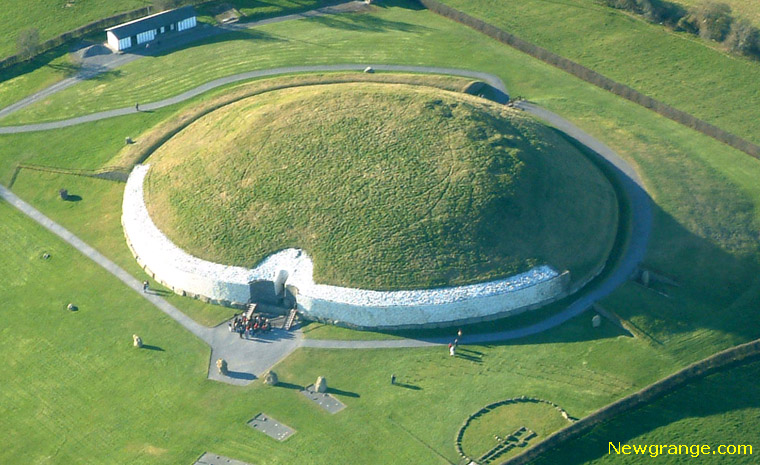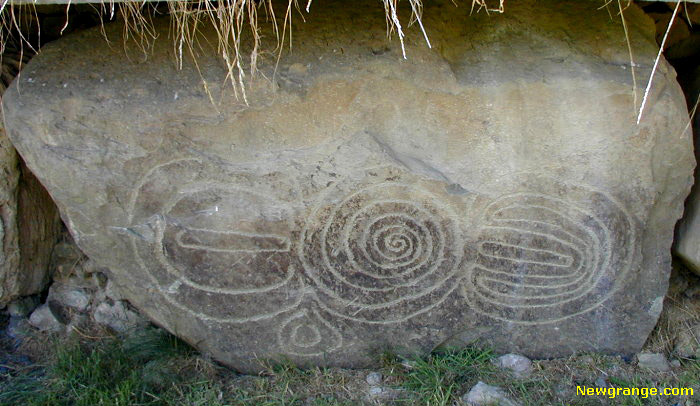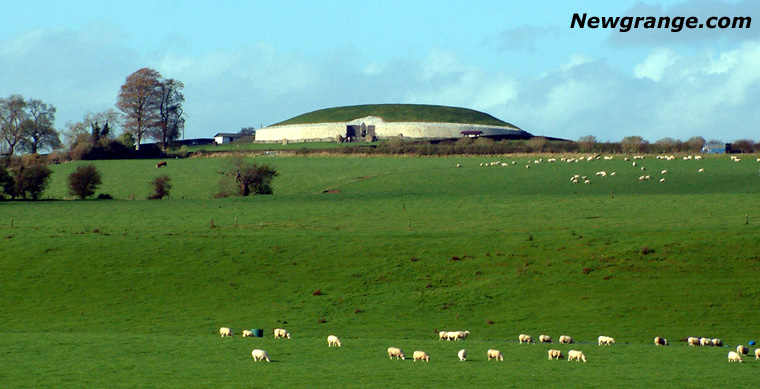Newgrange - A Womb Not a Tomb
Goddess Symbols and Ancient Ireland by Geraldine MoaneIn this article I would like to invoke the work of Marija Gimbutas as an inspiration for remembering the world of ancient Ireland, the world that built Newgrange over 5,000 years ago. To remember, or invent, such a world is not only an act of feminist imagination. It is an act of decolonizing the imagination. It is a reversal of the erasure of Irish culture and history, an evocation of a pre-colonial time of free-flowing spirituality and creativity, an envisioning of a society free of domination and alienation.
Old Europe
The two major works of Marija Gimbutas, The language of the Goddess and The Civilization of the Goddess, provide a visually compelling and inspiring compilation of the images and symbols of the goddess found during 20 years of archaeological research on Europe during the period from 7500 BCE to 3500 BCE. Along with her numerous other scholarly works, they show that during this time period (referred to by her as old Europe), religious and cultural life throughout Europe, from Spain and Ireland to the Ukraine in Russia, centred around veneration and celebration of nature in the form of the living body of a Goddess-Creator. Combined with such books as Mary Condren's The Serpent and the Goddess, and Gerda Lerner's The Creation of Patriarchy, they provide ample support for a goddess and woman-centred interpretation of Newgrange, Knowth, Dowth, and the myriad of other stone structures and carvings which are the legacy of ancient Ireland.Over the course of her career, Gimbutas has excavated or visited numerous sites in the Balkan area (Yugoslavia, Bulgaria), and examined many thousands of archaeological findings from sites all over Europe, including Spain, Ireland, Britain, France, Switzerland, Malta, Sardinia, Italy, Germany, Czechoslovakia, Yugoslavia, Romania, Bulgaria, and Russia. The picture that emerges is remarkably consistent and clear-cut. However, it is in marked contrast to traditional views, which presumed that societies were always hierarchical and god-centred, for it shows that prior to 3500 BCE, societies in Europe were egalitarian and non-violent, and were oriented towards nature, which was venerated primarily in the form of a woman's body.
The most striking feature of Old European societies that emerges from her archaeological findings is the centrality of artistic and religious life. Temples were widespread and prominent, and contained a wealth of artistic and ritualistic artifacts such as paintings, sculptures, pottery of all kinds, frescoes, and reliefs, usually decorated with specific motifs. Additionally, virtually every dwelling contained artifacts, pottery etc., arranged in groups on what could be called altars, in niches, or even on oven platforms, artifacts which were decorated with motifs similar to those found on temple artifacts. Even domestic tools such as lamps, spindle whorls, loom weights and other objects such as stones, bones, pendants, plaques, and seals, were decorated with these motifs.
Gimbutas has constructed the religion and cosmology of the time by a careful and detailed examination of the artifacts and of the motifs preserved on the artifacts. She concludes that throughout Old Europe people shared a complex, multifaceted conceptualization of nature and of the universe, and that they had developed shared ways of representing this understanding. More specifically, she concludes that nature was imbued with divinity, and was understood as a great goddess. The goddess was seen both as unitary, and as having a number of different aspects, all of which had specific representations. The goddess or her aspects could be represented concretely, as in a sculpture of a pregnant woman, or abstractly, using motifs or symbols.
Almost all of the figurines, sculpture, and pottery were decorated with abstract artwork such as spirals, triangles, V's, chevrons (columns of V's), wavy lines, zig-zags, circles, and semi-circles. About 15-20 motifs or symbols occur frequently throughout Europe, including Ireland, with up to 100 symbols occurring sporadically. Gimbutas concluded that the abstract symbols were part of a system of representation, and each symbol was associated with the great goddess or with an aspect of her. For example, a V or triangle represented the birth-giving aspect (vulva or pubic triangle), wavy lines represented the nourishing aspect (water or nourishing liquid), and triple lines represented the death-giving aspect. Double spirals or circles with lines radiating out represented the eyes of the goddess, and triple spirals, winding snakes, crescents, and sprouting seeds were used to symbolize the dynamic, cyclical, understanding of life and of the goddess.
These examples can only provide a hint of the complexity and ingenuity of the system described by Gimbutas. This system of representation was consistent throughout Old Europe, providing, as Gimbutas calls it in her book title, The language of the Goddess, with the abstract symbols representing what she calls a "metaphysical alphabet". Any artifact or carving, whether simple or complex, could be interpreted using this system. The goddess was, literally, everywhere, for as Gimbutas points out, it was sufficient merely to carve a triangle on a rock to evoke the birth-giving aspect of the goddess.
Ancient Irish society
The importance of this work for our understanding of ancient Ireland can hardly be exaggerated. The early inhabitants of Ireland left behind a multitude of stone monuments, carved with symbols which are completely consistent with those found elsewhere in Old Europe - symbols such as spirals, triangles, V's, wavy lines, and circles. When viewed using Marija Gimbutas' framework, this artwork confirms that the stone structures and art work of ancient Ireland can be seen as magnificent monuments to a religious and cosmological system similar to that of the rest of Old Europe.The best known of the Irish monuments is of course, Newgrange, dated at 3200 BCE, which has traditionally been seen as a tomb or cemetery. Newgrange consists of a large cairn or chamber with three cavities, which is covered by a very large mound of earth, 114 feet high and 130 feet in diameter. There is a long passageway through the mound leading into the chamber. This passageway is aligned so that at sunrise on winter solstice (and about three days before and after) a beam of sunlight enters the passage and glides up to illuminate the inner chamber. There are numerous huge boulders lining the passage-way into the chamber, and in the chamber itself, many of which are carved with the familiar spirals, triangles, chevrons, circles, and wavy lines described by Gimbutas.
There is also a ring of boulders, some carved, surrounding the mound. The carvings include examples of the symbolic representations of many of the aspects of the goddess which Gimbutas has identified. Significantly, triangles and spirals (birth-giving and regenerative symbols) are particularly prominent.
There can be little doubt that Newgrange represents the earth's womb, from which life comes and to which life returns - the birth-giving and regenerative aspects of the goddess. The astronomical alignment of Newgrange adds additional dimensions. As Martin Brennan points out in his book The Stars and the Stones, the interplay of light on carved stone allows for a more dynamic and interconnected interpretation of the symbols.
Newgrange is part of a large complex which includes two large structures similar to Newgrange, namely Knowth and Dowth. The complex also contains numerous socalled satellite structures, much smaller cairns which again are chambers entered by passageways, and covered with earth to form a mound. The whole set of large and small cairns are interconnected, and many of them are aligned to solar and lunar placements, and contain stones or boulders with symbolic carvings. The entire complex is located beside a bend in the River Boyne, and is referred to in the later Celtic mythology as Brugh na Boinne. Boinne is the generative form of Boann, goddess of the River Boyne.
Similar structures, but on a much smaller scale, (i.e. cairns covered with earth to make a mound, with a passageway entrance) are found at Loughcrew, which in Irish is called Sliabh na Caillighe (translating as Witch's Hill), at Carrowmore, where Maeve's cairn is located, and many other sites all over the country.
All in all there are thousands of stone structures all over Ireland, with a variety of forms, including cairns, dolmens, stone structures, wells, and single standing stones. It is clear that ancient Irish society devoted massive resources to the construction of these stone structures, and that the religion, cosmology, and symbolic system that underlie these structures were central to society. It is also clear that there is considerable continuity between Ireland and the cultures of Old Europe described by Gimbutas.
Ireland is described as a megalithic culture, along with Britain, Brittany, Spain, and Malta, because of the existence of enormous (mega) stone (lithic) structures such as Newgrange, Knowth, and Dowth. Most creative activity seems to have focused on large stones or stone structures. Very few artifacts such as pottery or figurines have been found, and there is little evidence of large scale settlements.
Rather than building temples, or making sculptures, pottery, or frescoes, the people devoted their energies to building large-scale stone structures, using enormous stone boulders onto which they carved symbolic representations similar to the ones found on the pottery and other artifacts found at other Old European sites. Thus the form of expression and representation is quite different in Ireland and other megalithic cultures, although the content is similar. Additionally, the astronomical alignments of the stone structures are only now being recognized and explored.
The astronomical alignments add new and complex dimensions. For example, as sunlight and moonlight enter the cairns, they illuminate different carved symbols at different times. More detailed investigation of this might reveal an actual narrative being spelt out as the different symbols are illuminated. Furthermore, the astronomical orientations, which are also found in megalithic structures in other cultures (e.g. Stonehenge), link the religious and cosmological system described by Gimbutas to the seasonal cycle of solstice, equinox, and cross-quarter days. Rituals and celebrations would obviously centre around these times, a feature which the stone age culture of Ireland shared with the later Celtic culture.
Conclusion
The work of Marija Gimbutas provides ample archaeological evidence to support the intuition long held by many Irish women that Newgrange is indeed a womb, and that it was built by a woman-centred and goddess oriented culture. The beauty and complexity of the artifacts described in her books, the coherence of the religion and cosmology constructed by her, and the ingenuity of the language of the goddess, all enhance both our understanding and our admiration for the magnificent monuments built by our ancestors. Yet the awesome sense of the power and mystery of Newgrange remains, for although Gimbutas has provided much illumination, our understanding of Newgrange and of ancient Irish society is still in its infancy.Journal Article originally published in Canadian Womens Studies - January 1997
Geraldine Moane
Geraldine Moane teaches in Psychology, Women's Studies, and Equalith Studies in University College Dublin. She has been active in the women's movement in Ireland since 1976 in the areas of violence, reproductive rights, and lesbian issues. She has just completed her book, Gender and Colonialism: A Psychological Analysis of Oppression and Liberation.Boyne Valley Private Day Tour
 Immerse yourself in the rich heritage and culture of the Boyne Valley with our full-day private tours.
Visit Newgrange World Heritage site, explore the Hill of Slane, where Saint Patrick famously lit the Paschal fire.
Discover the Hill of Tara, the ancient seat of power for the High Kings of Ireland.
Book Now
Immerse yourself in the rich heritage and culture of the Boyne Valley with our full-day private tours.
Visit Newgrange World Heritage site, explore the Hill of Slane, where Saint Patrick famously lit the Paschal fire.
Discover the Hill of Tara, the ancient seat of power for the High Kings of Ireland.
Book Now

Home
| Visitor Centre
| Tours
| Winter Solstice
| Solstice Lottery
| Images
| Local Area
| News
| Knowth
| Dowth
| Articles
| Art
| Books
| Directions
| Accommodation
| Contact




